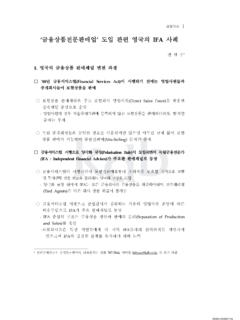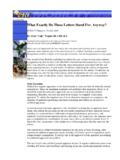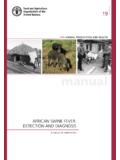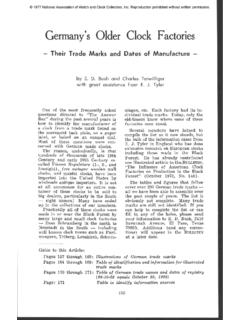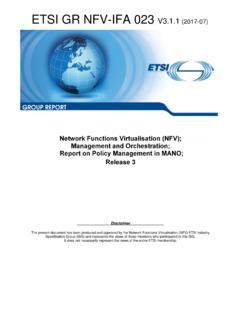Transcription of Modelling association football scores
1 Modelling association football scores by M. J. MAHER* Abstract Previous authors have rejected the Poisson model for association football scores in favour of the Negative Binomial. This paper, however, investigates the Poisson model further. Parameters representing the teams inherent attacking and defensive strengths are incorporated and the most appropriate model is found from a hierarchy of models. Observed and expected frequencies of scores are compared and goodness-of-fit tests show that although there are some small systematic differences, an independent Poisson model gives a reasonably accurate description of football scores . Improvements can be achieved by the use of a bivariate Poisson model with a correlation between scores of Key Words: Poisson goals distribution, iterative maximum likelihood.
2 1 Introduction MORONEY (1951) demonstrated that the number ofgoals scored by a team in a football match was not well fitted by a Poisson distribution but that ifa modified Poisson (the Negative Binomial, in fact) was used, the fit was much better. REEP, POLLARD and BENJAMIN (1971) confirmed this, using data from the English football League First Division for four seasons, and then proceded to apply the Negative Binomial distribu- tion to other ball games. The implication of this result is that the same Negative Bino- mial distribution applied to the number of goals scored by a team, regardless of the quality of that team or the quality of the opposition. In fact in an earlier paper, REEP and BENJAMIN (1968) remarked that chance does dominate the game . HILL (1974) was un- convinced by this and showed that football experts were able, before the season started, to predict with some success the final league table positions.
3 Therefore, certainly over a whole season, skill rather than chance dominates the game. This would probably be agreed by most people who watch the game of football ; that whilst in a single match, chance plays a considerable role (missed scoring opportunities, dubious offside deci- sions and shots hitting the crossbar can obviously drastically affect the result), over several matches luck plays much less ofa part. Teams are not identical; each one has its own inherent quality, and, surely then we should expect that when a good team is play- ing a weak team, the good team will have a high probability of winning and scoring several goals. By using data from the whole or just a part of the season, these inherent qualities of the teams in a league can be inferred by, for example, maximum likelihood estimation (as in THOMPSON (1975)) or by linear model methodology (as in HARVILLE (1977) and LEEFLANG and VAN PRAAG (1971)).
4 2 The Model There are good reasons for thinking that the number of goals scored by a team in a match is likely to be a Poisson variable: possession is an important aspect of football , * Department of Probability and Statistics, Sheffield University, Sheffield S3 7RH, England. Statistica Neerlandica 36 (1982), nr. 3. 109 and each time a team has the ball it has the opportunity to attack and score . The proba- bility p that an attack will result in a goal is, of course, small, but the number of times a team has possession during a match is very large. If p is constant and attacks are inde- pendent, the number of goals will be Binomial and in these circumstances the Poisson approximation will apply very well. The mean of this Poisson will vary according to the quality of the team and so if one were to consider the distribution ofgoals scored by all teams, one would have a Poisson distribution with variable mean, and hence something like the Negative Binomial observed by MORONEY (1951) and REEP, POLLARD and BENJAMIN (1971) could arise.
5 Therefore, in this paper, at least for the present, an independent Poisson model for scores will be adopted. In particular, if team iis playing at home against team jand the observed score is (xu, yu), we shall assume that X,, is Poisson with mean a,Jj, that Y,, is also Poisson with mean y, d,, and that Xu and Yu are independent. Then we can think of a, as representing the strength of team i s attack when playing at home& the weakness of teamj s defence when playing away, y, the weakness of team i s defence at home and d, the strength of teamj s attack away. In a league with 22 teams there are 88 such param- eters (and 924 observations on the scores ); however ifall the a s are multiplied by a fac- tor kand all theg s divided by k, all the a,& products are unaffected and, therefore, in order to produce a unique set of parameters the constraint may be imposed.
6 In the same way the constraint Cyi=cdi i I may be imposed and so only 86 independent parameters need to be specified. Since the - X and are assumed to be independent of each other (representing separate games at the two ends of the pitch), the estimation of the _a and4 will be entirely from the gand the estimation of the y and _S by means of the y alone. For the home teams scores , therefore, the log likelihood function is: i j+i Therefore, a log L xii -= aai j+i c (-A+;) and so the maximum likelihood estimates i,i satisfy: 110 An iterative technique, such as NEWTON-RAPHSON, enables these MLEs to be deter- mined. One simpler scheme which works well is to be use the 6 s to estimate thej s and then to use the g s to estimate the 63, and so on alternately. Good initial estimates can be gained by regarding the denominator terms in the expressions above as summations over all teams: that is, Ci= 1 xu/,& and jj= 1 xu/&, where &=I 1 xu.
7 J+ i i+. j i j=ei In a similar way, using the yo, and 3 may be found. 3 Results Data were obtained, in a convenient matrix form, from the Rothmans football Year- book (1973, 1974, 1975). This gave 12 separate leagues (the four English football League Divisions for each of three seasons) for analysis. The MLEs of the four types of parameterg,J,e,andJare shown in Table 1 forjust one data set: Division 1 in the season 197 1 - 1972. Table 1. Maximum likelihood estimates of the parameters for Division 1 1971-1972. home away home away attack defence defence attack a B Y 6 Arsenal Chelsea Coventry City Crystal Palace Derby County Everton Huddersfield Town lpswich Town Leeds United Leicester City Liverpool Manchester City Manchester United Newcastle United Nottingham Forest Sheffield United Southampton Stoke City Tottenham Hotspur West Bromwich Albion West Ham United Wolverhampton Wanderers The question arises of whether all these parameters are necessary for an adequate des- cription of the scores .
8 Intuitively it seems that there must be real differences between teams, but are these differences more apparent in the attacks or defences, and is it really necessary to have separate parameters for the quality of a team s attack at home and 111 away? Consideration of such questions leads to a possible hierarchy of models which could be tested. At the bottom is model 0 in which aj = a,Ji =J, yi = yand 6, = 6Vi; that is, all teams are identical in all respects. At the top is model 4, previously described, in which all four types of parameter are allowed to take different values for the different teams. The hierarchy is shown in Table 2. In this the notation is designed to show whether a set of parameters (such at theJ) are free to take different values for the dif- ferent teams (shown asg,) or whether the same value applies to all teams (shown asJ).
9 Table 2. Hierarchy of models, with changes in the value of twice the maxirnised log likelihood shown for Division I 1971-1972 ~ ~ ~~ Model 4 Models 3C, 3D Model 2 Models lA, 1B Model 0 In model 0 there are four parameters but in order to have a unique set ofparameter esti- mates, the constraints a =J and y = 6 are imposed (or, equivalently, a =J, y = kJ and 6 = ka), giving just two independent parameters. Details of the constraints imposed in the other models are as follows: Model IA Model IB Model 2 Model 3C Model 30 Model 4 6, = a, ,B, =J, y, = y Vi; Za, = a,. Therefore, there are n + 1 independent parameters (where n is the number of teams in the league). yI =8,, a, = a, 8, =J Vi; Za, = ZJl . Again, there are (n + 1) independent parameters. 6, = ka, , y, = kJ1 Vi; Za, = Z.
10 There are 2n independent parameters. S, = a, Vi; Za, = ZJ,. 3n - 1 independent parameters. y, =J, VI ; Zal = ZJ, . Again, 3n - 1 independent parameters. Za, = al and ZyI = 23,. Therefore, there are 4n - 2 independent param- eters. It can be seen, therefore, that moving up one level in the hierarchy of models leads to the introduction of (n - 1) further parameters. Under the null hypothesis that these extra parameters are unnecessary, 2 logel will be asymptotically Xj- I distribution by the usual likelihood ratio test, where logelis the increase in the log likelihood in moving from one model to the other. 112 Statistica Neerlandica 36 (1982), nr. 3. For Division 1 in the season 1971-1972 the changes in the value ofthe maximised log likelihood when moving from one model to another are shown in Table 2 (n=22; X.)


